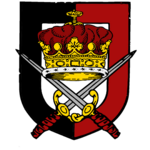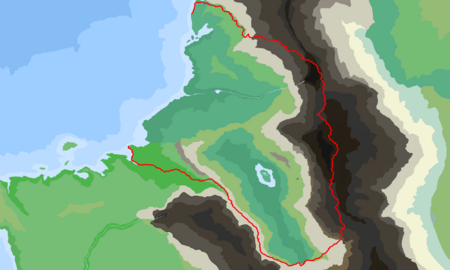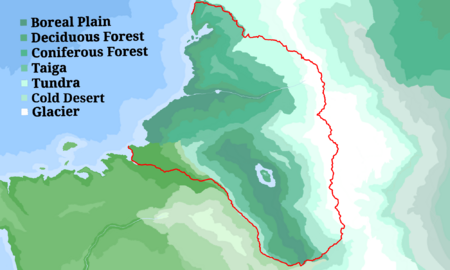Khijovia: Difference between revisions
No edit summary |
|||
| Line 136: | Line 136: | ||
===Archaios Aeon=== | ===Archaios Aeon=== | ||
The first | The first population of the Khijovian territory dates back to about 70,000 years ago by the Acreatics, a nomadic civilization of which the archaeological site of Yvernia on today's Pletorian coasts in particular is preserved among many; the site appears to be what remains of an anciently more articulated funerary complex presenting over 20 tombs with related funerary kits. The Acreatics therefore practiced the burial of the deceased and had a rather particular relationship with the concept of death: the skeletons were arranged with the head facing East to perhaps symbolize a second birth and the skulls were colored with red ocher to return blood, and therefore life, to the corpse. The walls of the funeral complex are also adorned with rock paintings with a propitiatory purpose, depicting shamanic rituals in particular. Burial was thus a magical rite, intended to prevent the soul of the dead from disturbing the existence of the living and intended to get rid of the spirit by granting it the way to new life; it is precisely in this culture that the first contacts with the magical arts in the Khijovian region occur. The large number of Venuses representing female creator deities found in the tombs, in addition, suggests that the social organization of the Acreatic civilization was the matriarchy for the direct relationship of women with fertility and reproduction. The Neolithic agricultural revolution did not excessively change the life of the Acreatics, who continued to base their livelihood on hunting and shellfish gathering. Starting from the twelfth millennium AR, however, probably as a result of climatic changes, this population moved away from the coasts and began to migrate towards the surrounding regions and, due to the mountainous nature of the territory, transhumant farming developed and subsequently agriculture also began to be practiced, thus marking the end of nomadism and the definitive sedentarization of the Acreatic people, now scattered throughout almost the entire Khijovian region. | ||
The greater availability of food guaranteed by agriculture and livestock produced as a result a great demographic increase and the consequent appearance of the first housing agglomerations. In this period the matriarchy would have disappeared due to the need for the presence of a male military leader to defend the villages and thus a transition towards a patriarchal society took place. The beginning of metallurgy in Khijovia gave rise to the cultures of the Copper Age: the [[Venatorian]] culture arose in the north, the [[Khantan]] culture in the east and the [[Koritian]] culture in the central-south. The Bronze Age instead led to the development of the [[Xomian]] culture on the island of [[Axiomia]] while the Iron Age gave birth to the [[Kleitite]] culture on the mouth of the [[Thevre]] river. Starting from around 1400 AR the large village centers would have evolved into real cities and a relationship of interdependence would have begun to be created between the city and the surrounding countryside: the farmlands produced the goods that are used to feed the urban center and the latter ensured a defense for the rural villages. The development of job specialization would eventually lead to a social hierarchy, at the top of which resided the ruling class of specialists, the future aristocratic caste. | |||
===Era of Ruin=== | ===Era of Ruin=== | ||
Revision as of 22:04, 7 May 2023
This article is incomplete because it is pending further input from participants, or it is a work-in-progress by one author. Please comment on this article's talk page to share your input, comments and questions. Note: To contribute to this article, you may need to seek help from the author(s) of this page. |
Ascended Kingdom of Khijovia Khıjœvïænne Æšcaeē Raēgə | |
|---|---|
Motto: "Vīəra unīəva Laexxe seþþ' Mætriannə jmørre" "Love of the Motherland is our only Law" | |
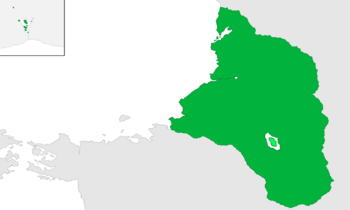 Lands and surroundings of the Ascended Kingdom of Khijovia | |
| Capital | Kleitore |
| Largest | Xoviah |
| Official languages | Khijovian |
| Recognised national languages | Khijovian |
| Recognised regional languages | Teutorian, Aldorian, Klettorian |
| Ethnic groups | Humans (100%) |
| Religion | Aravianism |
| Demonym(s) | Khijovian |
| Government | Feudalistic Constitutional Monarchy |
• Ascended King of Khijovia | Arcadion II |
• Ascended Queen of Khijovia | Carevia I |
| Legislature | Royal Parliament |
| Establishment | |
• Foundation of the Ascended Kingdom | July 3, 1611 AR |
| Area | |
• Land Area | 385,270 km2 (148,750 sq mi) |
• Water (%) | 6,8 |
| Population | |
• 1611 AR estimate | ~34,275,100 |
| GDP (nominal) | estimate |
• Per capita | 41,850 Shonnenors (46,220 USD) |
| Currency | Shonnenor (SHN) |
| Date format | dd/mm/yy |
| Driving side | right |
Khijovia (Khijovian: Khıjœvïæ [kɪjəʊviə]), officially The Ascended Kingdom of Khijovia, is a feudalistic constitutional monarchy located in northwestern Pelia (in a geographical region usually known as the High West) with Kleitore as its capital city. The nation has a population of about 34 million inhabitants and occupies the entire historical region of the same name, also possessing the Recondian Archipelago in the Wintry Ocean. Delimited to the east by the Clastoclite mountain range, Khijovia is bordered to the north by the Kyldigardian Confederation and to the south by Prestore, and faces the Kesper Sea to the west. The Ascended Kingdom was founded in 1611 AR by Arcadion II shortly after the collapse of the Khijovian Federation and after the return of the Zenonian Dynasty. The State is divided according to the Jovianic Feudal System into 27 administrative regions plus one special administrative district. A strongly spiritual society, Khijovia has always had a very special relationship with the magical arts.
Etymology
The etymology of the name Khijovia has always been the subject of reconstructions not only by linguists, but also by historians, traditionally attentive to the question; not always, however, we are faced with etymologies in the strict sense, rather with hypotheses which over time have formed a rich corpus of possible solutions, among which there are numerous that refer to popular traditions (such as the mythical existence of an ancient pre-Restart king named Khjvonnə).
It is thought that the name derives from the word Khyjvīə, an exoethnonym with which the Coritians designated a tribe that inhabited the bordering region of Aldoria. It is also hypothesized, however not in contrast with what has been said, that this people worshiped the simulacrum of a pagan divinity, Khœvă. According to this hypothesis, the name would therefore mean "inhabitants of the land of Khœvă".
A further hypothesis instead maintains that the origin of the name is simply the semantic union of the word Khvīəyutœnnə, a qualifying adjective of uncertain etymology which referred to the Holy Kveutonic Empire, with the term Jyœvïæhnnə, which referred to the Jovianic Order and its doctrine.
History
Despite all that prior to the Great Shuffle is basically unknown to the Sparkalian historians, the great cultural and historical heritage of Khijovia has managed to come down to us almost in its entirety thanks to the numerous archaeological sites, written finds and surviving traditions, thus allowing us to faithfully reconstruct the history of the Khijovian region.
A crossroads of numerous neolithic cultures, ancient Khijovia saw the birth and flourishing of a multitude of independent city-states that thrived for hundreds of years during the Era of Ruin, eagerly preserving their culture and language from outside meddling and influences. Following the collapse of the city-state system around 277 BR, the Khijovian territory was occupied by numerous nomadic peoples coming from the North, thus initiating the so-called Barren Age and ending the Archaic Age of Khijovian history. Being purely isolationists, the Khijovians were not concerned with the chaos and turmoil that was tearing apart the rest of Sparkalia, therefore they were not too much affected by wars and famines and continued to live peacefully. As the Great Shuffle occurred, Khijovia was struck with continental amnesia but her culture would manage to survive and persist into time to come.
Khijovia was then conquered without resistence and divided into multiple governatorates by the Kveutonic civilization in 87 AR, becoming one of the most important economic and cultural centers of the Holy Kveutonic Empire. Having reached its maximum expansion in the "heydays" (800-825 AR), the Kveutonic empire then dissolved in 902 due to the continuous invasions of barbarian peoples from the east, thus creating new independent statelets throughout the High West and sanctioning the birth of ancient religious-monastic military orders: among these was the Jovianic Order, which operated on the Khijovian region for more than a century until its disappearance around 1056.
Starting from 1152, the Grand Duke of Klettoria Zenon the Great launched a campaign of national unification and managed to defeat the rival House of Arenia for hegemony over Khijovia, then reuniting the agglomeration of territories into a single Kingdom on July 11, 1161: the Kingdom of Khijovia. Although hundreds of years of reign, on January 28, 1534 the Zenonian Dynasty was driven out in a coup d'état and the Khijovian Federation was founded. However, Federalist Khijovia had a short life as, with the return of the Zenonian Dynasty in 1610, the young prince Arcadion II managed to obtain power and bring the monarchy back to the country: on July 3, 1611 the Ascended Kingdom of Khijovia was founded.
Archaios Aeon
The first population of the Khijovian territory dates back to about 70,000 years ago by the Acreatics, a nomadic civilization of which the archaeological site of Yvernia on today's Pletorian coasts in particular is preserved among many; the site appears to be what remains of an anciently more articulated funerary complex presenting over 20 tombs with related funerary kits. The Acreatics therefore practiced the burial of the deceased and had a rather particular relationship with the concept of death: the skeletons were arranged with the head facing East to perhaps symbolize a second birth and the skulls were colored with red ocher to return blood, and therefore life, to the corpse. The walls of the funeral complex are also adorned with rock paintings with a propitiatory purpose, depicting shamanic rituals in particular. Burial was thus a magical rite, intended to prevent the soul of the dead from disturbing the existence of the living and intended to get rid of the spirit by granting it the way to new life; it is precisely in this culture that the first contacts with the magical arts in the Khijovian region occur. The large number of Venuses representing female creator deities found in the tombs, in addition, suggests that the social organization of the Acreatic civilization was the matriarchy for the direct relationship of women with fertility and reproduction. The Neolithic agricultural revolution did not excessively change the life of the Acreatics, who continued to base their livelihood on hunting and shellfish gathering. Starting from the twelfth millennium AR, however, probably as a result of climatic changes, this population moved away from the coasts and began to migrate towards the surrounding regions and, due to the mountainous nature of the territory, transhumant farming developed and subsequently agriculture also began to be practiced, thus marking the end of nomadism and the definitive sedentarization of the Acreatic people, now scattered throughout almost the entire Khijovian region.
The greater availability of food guaranteed by agriculture and livestock produced as a result a great demographic increase and the consequent appearance of the first housing agglomerations. In this period the matriarchy would have disappeared due to the need for the presence of a male military leader to defend the villages and thus a transition towards a patriarchal society took place. The beginning of metallurgy in Khijovia gave rise to the cultures of the Copper Age: the Venatorian culture arose in the north, the Khantan culture in the east and the Koritian culture in the central-south. The Bronze Age instead led to the development of the Xomian culture on the island of Axiomia while the Iron Age gave birth to the Kleitite culture on the mouth of the Thevre river. Starting from around 1400 AR the large village centers would have evolved into real cities and a relationship of interdependence would have begun to be created between the city and the surrounding countryside: the farmlands produced the goods that are used to feed the urban center and the latter ensured a defense for the rural villages. The development of job specialization would eventually lead to a social hierarchy, at the top of which resided the ruling class of specialists, the future aristocratic caste.
Era of Ruin
Archaic Age
Barren Age
Nova Antiquity and Medieval Era
Kveutonic Age
Jovianic Domination
Modern Era
Surgence Epoch
Zenonian Age
Contemporary Age
Federalist Parenthesis
Ascension Period
Geography
Physical Geography
Belonging to a larger geographical region called the High West, the Khijovian region features one of the most substantial ranges of landscapes of the Pelian continent. Bordering the Kyldigardian region to the north, Khijovia is completely enclosed to the east by the Clastoclite range and to the south by the Stornic massif. The Khijovian soil, slightly anthropized, has a wide range of characteristics and has a prevalence of hilly areas compared to mountainous and flat zones, with the average altitude of the territory of about 630 meters above sea level.The mountain ranges extend throughout the eastern part of the nation, in fact a good part of the western side of the Clastoclite system belongs to Khijovia. The highest Khijovian peaks are found in the central Clastoclites, where there are numerous peaks exceeding 4500m including Mount Eletherium (4910m), the highest mountain in the Clastoclite range. The Khijovian mountainous territory has also been shaped over time by an ancient glacial mass dating back to the Cenozoic which has left long moraines flanking the western Clastoclite slope, forming in the meantime also wide higlands in the north and a multitude of shallow valleys among the southern hills.
The plains of Khijovia include the Catridian plain, an alluvial expanse formed by the Thevre river and its tributaries which extends up to Pyrisia, the Betronic plains, uplift plains along the coasts of Androvia and of Charonthia, and finally the Platic plain, an oblong flat valley of tectonic type which surrounds the Axiomia Lake and which runs from Cassiopia to Carcassionia.
Most of the Khijovian isles are collected in small archipelagos, such as Cheronia off the Charonthic coasts and Recondia, a polar archipelago of volcanic origin lying within a deep lagoon connected to the Wintry Ocean by narrow inlets and surrounded entirely by ice cap glaciers.
Geology
Volcanism
Seismic Activity
Hydrography
Climate
Meteorology
Ecosystem
Thanks to its rich geographical diversity, the Khijovian region hosts a varied collection of unique biomes that make the national territory one of the most characteristic and peculiar of the whole of Pelia, presenting an articulated biotic whole that makes the Khijovian ecosystem so very fascinating and highly biodiverse.
Biomes
Flora
Fauna
Politics
State Structure
Administrative Regions
| Region | Map of the Khijovian Administrative Regions | |
|---|---|---|
| 1 | Klettoria | 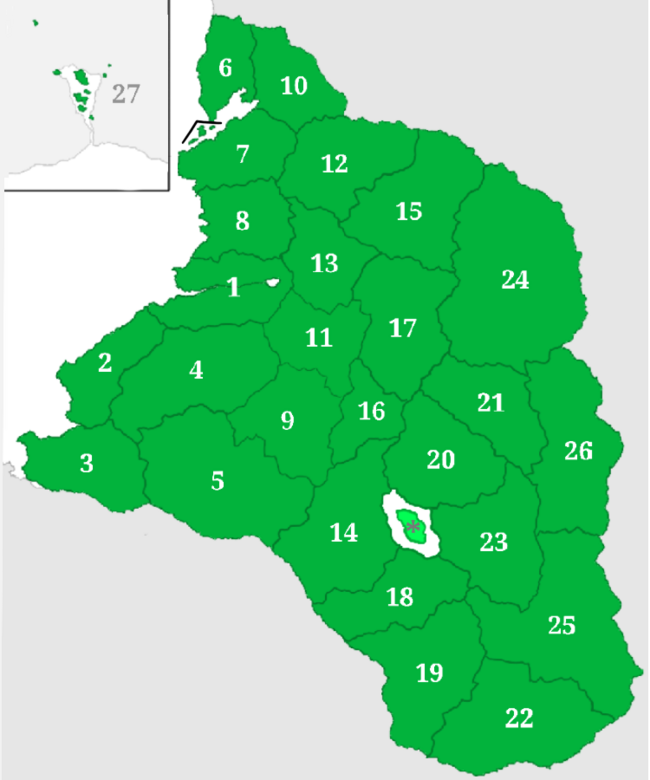
|
| 2 | Luriah | |
| 3 | Pyrisia | |
| 4 | Qaylasiah | |
| 5 | Atredia | |
| 6 | Chondia | |
| 7 | Charonthia | |
| 8 | Androvia | |
| 9 | Ketheria | |
| 10 | Iverniah | |
| 11 | Kharpovia | |
| 12 | Venatoria | |
| 13 | Profania | |
| 14 | Coritia | |
| 15 | Bellatoria | |
| 16 | Cassiopia | |
| 17 | Corkoviah | |
| 18 | Aldoria | |
| 19 | Teutoria | |
| 20 | Garganthia | |
| 21 | Krakoviah | |
| 22 | Carcassonia | |
| 23 | Sopholenia | |
| 24 | Karkarovia | |
| 25 | Kenveciah | |
| 26 | Akrocanthia | |
| 27 | Recondia | |
| * | Axiomia | |

